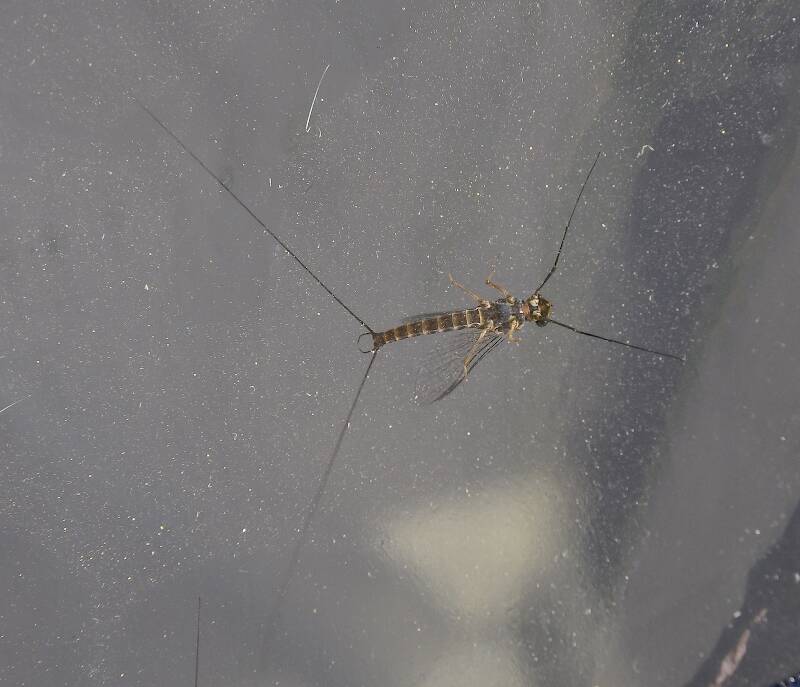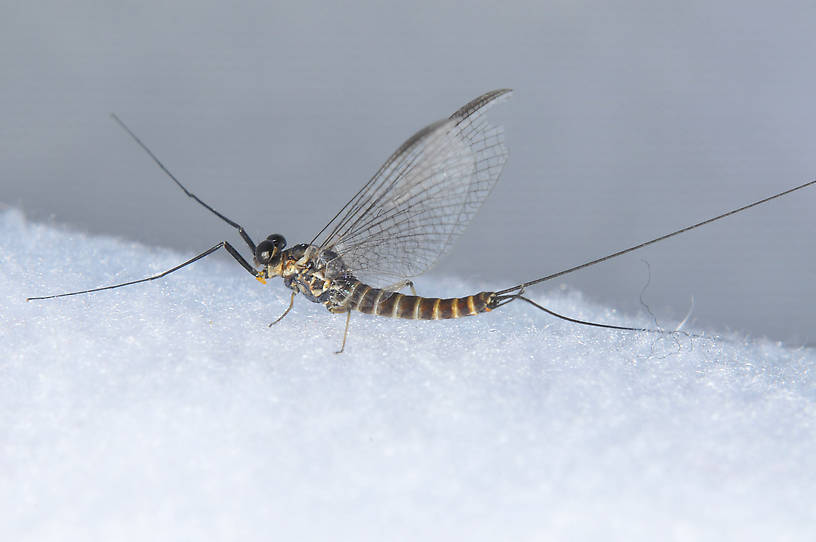
Blue-winged Olives
Baetis
Tiny Baetis mayflies are perhaps the most commonly encountered and imitated by anglers on all American trout streams due to their great abundance, widespread distribution, and trout-friendly emergence habits.


Mayfly Species Rhithrogena robusta
Where & when
Fred Arbona calls this species "fairly common throughout the West," but I have found no other information about it.In 12 records from GBIF, adults of this species have been collected during July (67%), August (8%), May (8%), June (8%), and April (8%).
In 17 records from GBIF, this species has been collected at elevations ranging from 1969 to 11037 ft, with an average (median) of 8871 ft.
Species Range
Physical description
Most physical descriptions on Troutnut are direct or slightly edited quotes from the original scientific sources describing or updating the species, although there may be errors in copying them to this website. Such descriptions aren't always definitive, because species often turn out to be more variable than the original describers observed. In some cases, only a single specimen was described! However, they are useful starting points.
Male Spinner
Wing length: 14 mm
A large dark brown species, allied to Rhithrogena brunneotincta; dark mid-ventral ganglionic marks.
Head and thorax deep black-brown. A paler brown area anterior to wing roots; intersegmental areas of pleura pale brown. Fore leg dark brown; middle and hind legs slightly paler brown. No distinct dark streaks or dots on femora. Apices of femora, claws, tarsal joinings of middle and hind legs darker brown. Wings hyaline; stigmatic area distinctly brown-tinged, mainly in costal space, venation deep brown; longitudinal veins heavier than cross veins. Humeral cross veins light red-brown, pale at costal margin. Basal costal and subcostal cross veins quite pale and faint. Stigmatic cross veins of costa anastomosed as usual.
Abdominal segments 2-7 semi-hyaline; lateral and posterior margins of segments, and intersegmental areas, pale yellowish brown. Remainder of each tergite dark red-brown; of each sternite paler red-brown. Narrow paler mid-dorsal line and pale hyaline wedge-shaped submedian streaks near center of each tergite. Ganglionic areas of apical sternites blackish; these areas outlined in dark brown on basal and middle sternites. Segments 8-10 opaque, darker; almost, black-brown. Genitalia dark red-brown. Penes widely divergent apically, tips roundly truncate. Three spines on apical portion; two on inner margin, of which the smaller is directed upward and the larger, its tip slightly curved, is directed inward; the one nearer the outer margin is short and stout. A long spine-like lateral process, its tip truncate, slightly curved outward, on outer margin of each side, above base (see fig. 101).
The brown-tinted wings of R. brunneotincta, as well as structural details of the penes, distinguish that species from R. robusta, to which it is closely allied.
Specimens of the Mayfly Species Rhithrogena robusta
2 Male Spinners
Start a Discussion of Rhithrogena robusta
References
- Arbona, Fred Jr. 1989. Mayflies, the Angler, and the Trout. Nick Lyons Books.
- Needham, James G., Jay R. Traver, and Yin-Chi Hsu. 1935. The Biology of Mayflies. Comstock Publishing Company, Inc.
Mayfly Species Rhithrogena robusta
Species Range
Resources
- NatureServe
- Integrated Taxonomic Information System
- Global Biodiversity Information Facility
- Described by Dodds (1923)



